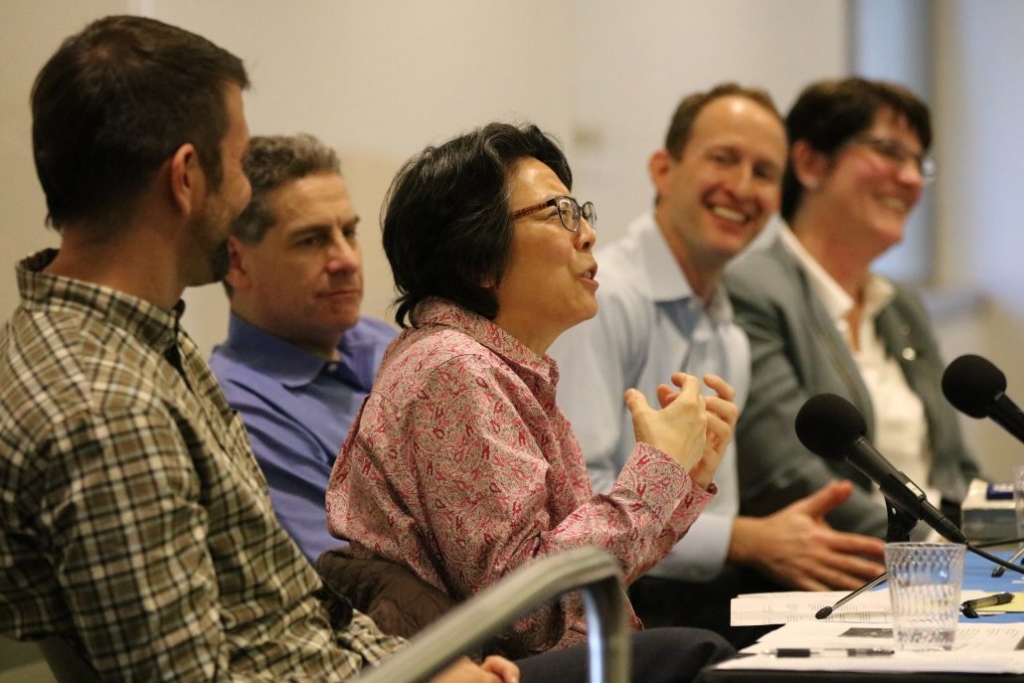With the city of Los Angeles’ March 7 election looming, UCLA’s Lewis Center convened a panel of legal and land use experts to discuss the impact of Measure S, called the “Neighborhood Integrity Initiative” by its supporters.
The measure is arguably the single-biggest decision voters will have to make in L.A. on the March 7 ballot since Measure S would place a two year ban on changes to zoning for individual projects, essentially placing a moratorium on a significant number of new housing projects, including affordable housing and permanent affordable housing for people struggling with homelessness.
The measure also mandates the city to update its neighborhood plans. Though the city has attempted updates of these plans in the past, they have regularly been stalled by the same litigious anti-growthers that are pushing Measure S.
“The most important thing about Measure S is probably the threat of Measure S,” Jonathan Zasloff, a professor of Law at UCLA School of Law, said to a crowded lecture hall on Thursday.
Though Zasloff is on the record as opposing Measure S, he noted that it had motivated the Los Angeles City Council to commit to making some changes to the city’s planning process. The day of the panel, the L.A. City Council voted unanimously to institute requirements that the city’s community plans be updated every six years.
While there was general agreement that one of the root causes of the discontent that lead to Measure S was Los Angeles’ arcane and outdated planning processes, the panel felt that Measure S is far from the answer.
“The political theory behind the initiative is that it will force reform of the planning system,” Zasloff said.
But his colleague and fellow panelist, Joan Ling, a longtime lecturer in the UCLA Luskin Department of Urban Planning, called the idea “wishful thinking” on the part of the measure’s supporters.
“Particularly in affluent areas, there is no reason why the electorate and the council members would want to reform land use to allow for more density,” she said.
But density near transit with reduced parking requirements with strong protections for existing, especially rent controlled housing, is precisely what is needed to address some of the major problems currently facing in Los Angeles: traffic and housing costs.
Measure S addresses none of those issues and specifically limits the city’s powers to approve variances that reduce required on-site parking. According to a recent transit-oriented development study, U.S. cities build way too much parking. According to the study, even at peak times, L.A.’s Wilshire Vermont Station Apartments parking spots were only two-thirds full. These excessive parking requirements drive up the cost of housing, but Measure S would make impossible to reduce the amount of parking we build going forward.
Michael Manville, assistant professor of urban planning, echoed Ling’s comments.
He noted that despite claims by its supporters, Measure S really won’t help with traffic.
“It ends up being a very small and uncertain reduction in traffic, played against a much more certain cost in housing prices,” he said.
“We’re not going to unbuild the area,” he said, noting that failing to build close to transit and near jobs won’t stop people from coming to Los Angeles, but instead force them farther to the outskirts of the city from where they will have to drive to jobs, actually potentially making traffic worse.
Another aspect of the measure is its two-year ban on changing zone designations for particular sites. Changing a property from an industrial designation to a multi-family designation would be banned for most parcels during the moratorium and potentially longer. Redevelopment of existing residential properties would be permitted however, since no zone changes would be required, a fact that could lead to the loss of older rent controlled housing.
Thursday's full panel discussion is available above and readers can click here for the UCLA Lewis Center's write up of the event.







